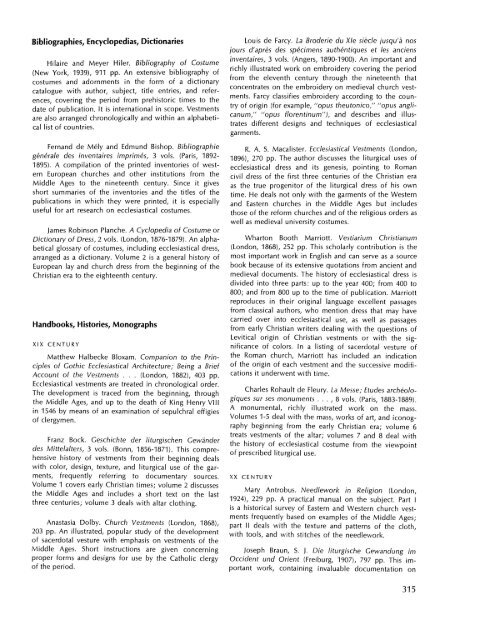The Metropolitan Museum of Art Bulletin, v. 29, no. 7 (March, 1971)
The Metropolitan Museum of Art Bulletin, v. 29, no. 7 (March, 1971)
The Metropolitan Museum of Art Bulletin, v. 29, no. 7 (March, 1971)
You also want an ePaper? Increase the reach of your titles
YUMPU automatically turns print PDFs into web optimized ePapers that Google loves.
Bibliographies, Encyclopedias, Dictionaries<br />
Hilaire and Meyer Hiler. Bibliography <strong>of</strong> Costume<br />
(New York, 1939), 911 pp. An extensive bibliography <strong>of</strong><br />
costumes and adornments in the form <strong>of</strong> a dictionary<br />
catalogue with author, subject, title entries, and references,<br />
covering the period from prehistoric times to the<br />
date <strong>of</strong> publication. It is international in scope. Vestments<br />
are also arranged chro<strong>no</strong>logically and within an alphabetical<br />
list <strong>of</strong> countries.<br />
Fernand de Mely and Edmund Bishop. Bibliographie<br />
generale des inventaires imprim6s, 3 vols. (Paris, 1892-<br />
1895). A compilation <strong>of</strong> the printed inventories <strong>of</strong> western<br />
European churches and other institutions from the<br />
Middle Ages to the nineteenth century. Since it gives<br />
short summaries <strong>of</strong> the inventories and the titles <strong>of</strong> the<br />
publications in which they were printed, it is especially<br />
useful for art research on ecclesiastical costumes.<br />
James Robinson Planche. A Cyclopedia <strong>of</strong> Costume or<br />
Dictionary <strong>of</strong> Dress, 2 vols. (London, 1876-1879). An alphabetical<br />
glossary <strong>of</strong> costumes, including ecclesiastical dress,<br />
arranged as a dictionary. Volume 2 is a general history <strong>of</strong><br />
European lay and church dress from the beginning <strong>of</strong> the<br />
Christian era to the eighteenth century.<br />
Handbooks, Histories, Mo<strong>no</strong>graphs<br />
XIX CENTURY<br />
Matthew Halbecke Bloxam. Companion to the Principles<br />
<strong>of</strong> Gothic Ecclesiastical Architecture; Being a Brief<br />
Account <strong>of</strong> the Vestments . . . (London, 1882), 403 pp.<br />
Ecclesiastical vestments are treated in chro<strong>no</strong>logical order.<br />
<strong>The</strong> development is traced from the beginning, through<br />
the Middle Ages, and up to the death <strong>of</strong> King Henry VIII<br />
in 1546 by means <strong>of</strong> an examination <strong>of</strong> sepulchral effigies<br />
<strong>of</strong> clergymen.<br />
Franz Bock. Geschichte der liturgischen Gewander<br />
des Mittelalters, 3 vols. (Bonn, 1856-1871). This comprehensive<br />
history <strong>of</strong> vestments from their beginning deals<br />
with color, design, texture, and liturgical use <strong>of</strong> the garments,<br />
frequently referring to documentary sources.<br />
Volume 1 covers early Christian times; volume 2 discusses<br />
the Middle Ages and includes a short text on the last<br />
three centuries; volume 3 deals with altar clothing.<br />
Anastasia Dolby. Church Vestments (London, 1868),<br />
203 pp. An illustrated, popular study <strong>of</strong> the development<br />
<strong>of</strong> sacerdotal vesture with emphasis on vestments <strong>of</strong> the<br />
Middle Ages. Short instructions are given concerning<br />
proper forms and designs for use by the Catholic clergy<br />
<strong>of</strong> the period.<br />
Louis de Farcy. La Broderie du Xle siecle jusqu'a <strong>no</strong>s<br />
jours d'apres des specimens authentiques et les anciens<br />
inventaires, 3 vols. (Angers, 1890-1900). An important and<br />
richly illustrated work on embroidery covering the period<br />
from the eleventh century through the nineteenth that<br />
concentrates on the embroidery on medieval church vestments.<br />
Farcy classifies embroidery according to the country<br />
<strong>of</strong> origin (for example, "opus theutonico," "opus anglicanum,"<br />
"opus florentinum"), and describes and illustrates<br />
different designs and techniques <strong>of</strong> ecclesiastical<br />
garments.<br />
R. A. S. Macalister. Ecclesiastical Vestments (London,<br />
1896), 270 pp. <strong>The</strong> author discusses the liturgical uses <strong>of</strong><br />
ecclesiastical dress and its genesis, pointing to Roman<br />
civil dress <strong>of</strong> the first three centuries <strong>of</strong> the Christian era<br />
as the true progenitor <strong>of</strong> the liturgical dress <strong>of</strong> his own<br />
time. He deals <strong>no</strong>t only with the garments <strong>of</strong> the Western<br />
and Eastern churches in the Middle Ages but includes<br />
those <strong>of</strong> the reform churches and <strong>of</strong> the religious orders as<br />
well as medieval university costumes.<br />
Wharton Booth Marriott. Vestiarium Christianum<br />
(London, 1868), 252 pp. This scholarly contribution is the<br />
most important work in English and can serve as a source<br />
book because <strong>of</strong> its extensive quotations from ancient and<br />
medieval documents. <strong>The</strong> history <strong>of</strong> ecclesiastical dress is<br />
divided into three parts: up to the year 400; from 400 to<br />
800; and from 800 up to the time <strong>of</strong> publication. Marriott<br />
reproduces in their original language excellent passages<br />
from classical authors, who mention dress that may have<br />
carried over into ecclesiastical use, as well as passages<br />
from early Christian writers dealing with the questions <strong>of</strong><br />
Levitical origin <strong>of</strong> Christian vestments or with the significance<br />
<strong>of</strong> colors. In a listing <strong>of</strong> sacerdotal vesture <strong>of</strong><br />
the Roman church, Marriott has included an indication<br />
<strong>of</strong> the origin <strong>of</strong> each vestment and the successive modifications<br />
it underwent with time.<br />
Charles Rohault de Fleury. La Messe; Etudes archeologiques<br />
sur ses monuments . . ., 8 vols. (Paris, 1883-1889).<br />
A monumental, richly illustrated work on the mass.<br />
Volumes 1-5 deal with the mass, works <strong>of</strong> art, and ico<strong>no</strong>graphy<br />
beginning from the early Christian era; volume 6<br />
treats vestments <strong>of</strong> the altar; volumes 7 and 8 deal with<br />
the history <strong>of</strong> ecclesiastical costume from the viewpoint<br />
<strong>of</strong> prescribed liturgical use.<br />
XX CENTURY<br />
Mary Antrobus. Needlework in Religion (London,<br />
1924), 2<strong>29</strong> pp. A practical manual on the subject. Part I<br />
is a historical survey <strong>of</strong> Eastern and Western church vestments<br />
frequently based on examples <strong>of</strong> the Middle Ages;<br />
part II deals with the texture and patterns <strong>of</strong> the cloth,<br />
with tools, and with stitches <strong>of</strong> the needlework.<br />
Joseph Braun, S. J. Die liturgische Gewandung im<br />
Occident und Orient (Freiburg, 1907), 797 pp. This important<br />
work, containing invaluable documentation on<br />
315

















